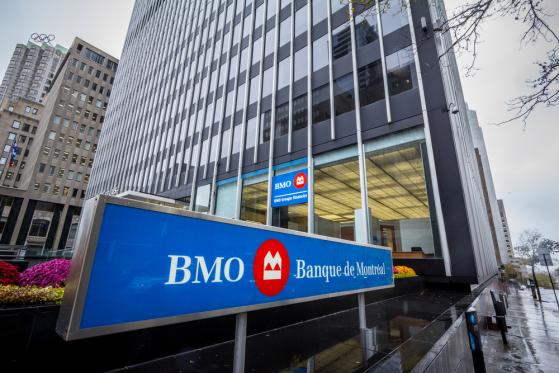The Bank of Montreal (TSX: TSX:BMO) stock price is the worst-performer among the big 4 Canadian banks this year. It has dropped by over 13% this year while TD has dropped by 5.10% and Bank of Nova Scotia (TSX:BNS) is barely moved. Royal Bank of Canada (TSX:RY) (RBC) stock has risen by over 13% this year.
Concerning Canadian macros
Canadian banks have continued to underperform their American and European peers this year. In the US, companies like Citigroup, JPMorgan (NYSE:JPM), and Goldman Sachs (NYSE:GS) have all rallied by double-digits this year.
Similarly, in Europe, banks like Unicredit (BIT:CRDI), Lloyds (LON:LLOY), and Lloyds recently rose to their multi-year highs.
BMO vs TD vs Royal Bank of Canada vs Bank of Nova Scotia vs Citi vs JPMorgan
This performance is mostly because of the challenging macro situation in Canada, where the unemployment rate has continued rising.
Inflation has moderated, opening the door for interest rate cuts by the Bank of Canada (BoC). The bank slashed rates by 0.25% in the last meeting to 4.75%.
Therefore, analysts have embraced a cautious outlook for these Canadian banks. In a recent note, those at UBS initiated the sector coverage with a buy rating and noting that they favored RBC because of its revenue diversification, especially in the capital markets side. It has a neutral rating on banks like BMO, BNS, and CIBC (TSX:CM),
BMO slow growth
Bank of Montreal is one of the biggest banks in Canada and the 9th one in North America in terms of assets. It serves over 13 million customers across it personal, commercial, markets, and investment banking divisions. It has over $1.4 trillion in assets.
BMO makes most of its revenue from its P&C division, which includes its Canadian personal and business banking and commercial division. The rest comes from its US P&C division followed by capital markets and wealth management.
Its capital markets business has come under pressure in the past few years as the industry has slowed down after booming during the pandemic.
In its financial results, the company said that its adjusted net income dropped from $2.186 billion in 2023 to $2.03 billion. Its reported net income of $1.86 billion was higher than the $1.02 billion it made a year earlier, helped by non-interest income. Despite higher interest rates, BMO’s net interest income dropped to $4.5 billion.
The company’s reported earnings was $2.36 per share compared to $1.26 a year earlier. Its CET1 ratio was 13.1%, meaning that it has little room to boost its shareholder returns by taking some of its reserves. Many European banks have been reducing their reserves and raising their capital returns.
BMO has set medium term (3-5 years) targets for its EPS and other metrics. It expects to have an EPS growth rate of between 7% and 10% a year, a return on equity of over 15% and return on tangible common equity (RoTE) of over 18%.
While interest rates have benefited the company, they have also impacted its provisions. In its most recent results, its provision for credit losses stood at over $705 million.
RBC downgrades BMO shares
The other challenge is one that was identified by RBC Bank on Tuesday when it downgraded BMO to sector perform. In a statement, Darko Mihelic warned that RBC was accumulating credit losses at a faster pace in the US than its competitors. He then slashed the stock target to $118 from $124. He said:
“We have seen enough evidence that BMO’s credit is not as strong as we once thought and hence a lower valuation is warranted. We believe that as the credit cycle progresses, BMO’s risk premium will move higher, as BMO’s U.S. credit result appears to be an outlier among its U.S. peer group.”
Still, BMO supporters point to its attractive valuation metrics compared to its other banks and other companies. It has a price-to-earnings ratio of 10, lower than other banks. Its price-to-book ratio stood at 1.07, down than over 1.5 earlier this year. RBC Bank has a P/B ratio of 1.92 while TD Bank (TSX:TD) has 1.36.
Also, the company has a strong and safe dividend. It has a dividend yield of over 5%, higher than most banks.
BMO stock price analysis
BMO chart by TradingView
The weekly chart shows that the BMO share price has been under pressure since 2022. It has dropped from the year-to-date high of $137.31 in March 2022 to $114.
The stock is hovering at the 50-week and 100-week Exponential Moving Averages (EMA). At the same time, BMO shares have formed a bullish flag chart pattern. In most cases, this pattern is one of the most bullish signs in the market.
BMO has also moved to the corrective wave of the Elliot Wave chart pattern. Therefore, the stock will likely remain in this range in the next few days. It will then move to the next key support level to watch being at $100.
On the flip side, the alternative scenario is where the stock bounces back and moves to the upper side of the flag at $129.
This article first appeared on Invezz.com
